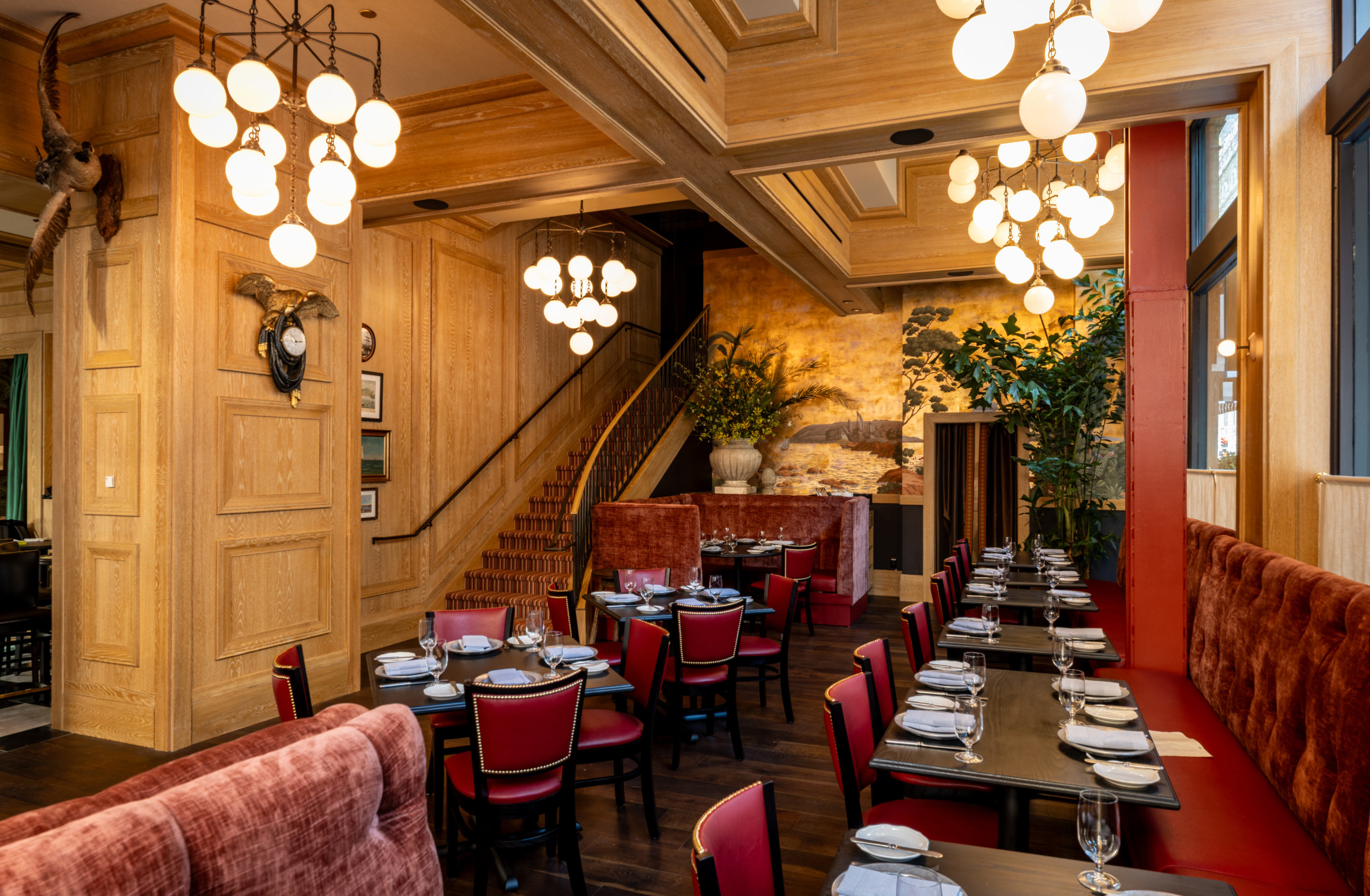
The restaurant industry is experiencing a technological renaissance, and artificial intelligence is leading the charge. As we move through 2025, AI-driven reservation systems are no longer a futuristic concept—they're becoming essential tools for restaurants looking to thrive in an increasingly competitive landscape. The global food service market, valued at $2.52 trillion in 2021, is projected to reach $4.43 trillion by 2028, and AI is playing a crucial role in this growth (Artificial Intelligence-Driven Personalization in Restaurant Guest Experiences).
What makes this transformation particularly exciting is how AI is revolutionizing the front-of-house experience. Companies like Newo.ai, Slang, RestoHost, Hostie, Revmo, and PolyAI are not just managing bookings; they are engaging in natural conversations, handling multiple languages, and showcasing soft skills previously thought to be exclusive to humans (Forbes: How AI is Transforming Restaurants). The results speak for themselves: AI hosts are generating an additional revenue of $3,000 to $18,000 per month per location, up to 25 times the cost of the AI host itself (Forbes: How AI is Transforming Restaurants).
For restaurant owners, this isn't just about keeping up with technology—it's about survival and growth in an industry where 63% of Americans say calling is their preferred way to contact a restaurant, and more than two-thirds (69%) would give up on going to a restaurant if no one answers the phone (Missed Connection: Over Two-Thirds of Americans Would Ditch Restaurants That Don't Answer the Phone).
The numbers tell a compelling story about AI's rapid adoption in the restaurant industry. The food and beverage AI market is currently valued at $9.68 billion and is expected to reach $49 billion over the next five years (AI's Critical Role in Shaping the Future of the Restaurant Industry). This explosive growth reflects not just technological advancement, but a fundamental shift in how restaurants operate.
The global food automation market is projected to reach $14 billion by the end of 2024, with a potential 69% increase in the use of AI and robotics in fast food restaurants by 2027 (Why AI is 2024's top restaurant tech trend). These statistics underscore a reality that forward-thinking restaurant owners are already embracing: AI is no longer optional—it's becoming essential for competitive operations.
The practical benefits of AI reservation systems are already being realized by early adopters. Modern AI hosts can enhance efficiency, personalization, and guest satisfaction by engaging in natural conversations across multiple languages, handling bookings without human intervention, including complex modifications, and remembering guest preferences and special occasions (Forbes: How AI is Transforming Restaurants).
What's particularly impressive is how quickly these systems can be deployed. Newo.ai allows restaurants to create their AI host in one click within minutes, with implementation possible in under an hour by feeding it the restaurant's menu, signature dishes, and reservation schedules (Forbes: How AI is Transforming Restaurants). This rapid deployment capability means restaurants can start seeing benefits almost immediately.
The restaurant industry faces significant staffing challenges that AI is uniquely positioned to address. Low pay, high stress, worker competition, and reluctance from those laid off during the pandemic to return, on top of poor working conditions, have led to a chronic shortage of entry-level staff in Canada's hospitality industry (Forbes: How AI is Transforming Restaurants). Similar challenges exist across North America, making AI solutions not just convenient but necessary.
In multicultural cities like Toronto and Montreal, AI systems offer a distinct advantage with their multilingual capabilities, enabling smoother communication with diverse clientele and enhancing the overall customer experience (Forbes: How AI is Transforming Restaurants). This capability is becoming increasingly valuable as restaurants serve more diverse customer bases.
Voice AI is experiencing a breakthrough moment in 2025. Platforms like ConverseNow are facilitating over 2,000,000 conversations per month and repurposing over 83,000 labor hours monthly (ConverseNow). This massive scale demonstrates that voice-assisted booking isn't just a novelty—it's becoming a cornerstone of restaurant operations.
The sophistication of these systems has reached a point where 89% of Americans would be open to using an AI agent for tasks related to interacting with a restaurant (Missed Connection: Over Two-Thirds of Americans Would Ditch Restaurants That Don't Answer the Phone). This high acceptance rate indicates that consumers are ready for AI-powered interactions, removing a significant barrier to adoption.
Major restaurant chains are taking notice. In June 2025, Dine Brands, the parent company of Applebee's and IHOP, announced plans to implement artificial intelligence in their restaurants, testing Voice AI Agents to handle customer orders over the phone (Smart Service Revolution: Applebee's and IHOP Turn to AI Employees for Restaurant Efficiency). This move by such established brands signals that voice AI has moved from experimental to mainstream.
The evolution of AI has moved far beyond simple rule-based systems. In April 2025, a range of AI models including GPT-4.5, GPT-4o, Claude 3.7, Grok 3, O3, and DeepSeek R1 were benchmarked not only on accuracy or speed, but also on their ability to behave, respond, and relate like humans (73% Passed the Turing Test? What We Learned from Benchmarking GPT-4.5, Claude 3.7, Grok 3 & O3 on Human-Like Behavior). This advancement means restaurant AI systems can now provide genuinely human-like interactions.
Machine learning algorithms are enabling AI systems to learn from every interaction, continuously improving their ability to handle complex reservation requests, understand context, and provide personalized service. Most restaurant personalization currently operates on simple rule-based/expert systems rather than machine learning algorithms, but this is rapidly changing (Artificial Intelligence-Driven Personalization in Restaurant Guest Experiences).
AI applications in restaurants now include predictive analytics for inventory management and AI-powered algorithms for personalized marketing (The Role of AI in Restaurants - Trends for 2024). These capabilities are extending to reservation systems, where AI can predict demand patterns, optimize table allocation, and even suggest dynamic pricing strategies for peak times.
The ability to analyze customer data from point-of-sale (POS) systems enables restaurant operators to offer customized recommendations, enhancing the overall dining experience and boosting customer loyalty (AI's Critical Role in Shaping the Future of the Restaurant Industry). This data-driven approach transforms reservations from simple booking tools into revenue optimization engines.
The sophistication of natural language processing in restaurant AI has reached remarkable levels. AI assistants are already in use by early adopters, often without guests realizing it (Forbes: How AI is Transforming Restaurants). This seamless integration demonstrates how far the technology has progressed in understanding and responding to natural human speech patterns.
Modern AI systems can handle complex modifications to reservations, manage waitlists dynamically, provide real-time updates on table availability, cross-sell special events and promotions, and address dietary restrictions and special requests (Forbes: How AI is Transforming Restaurants). This comprehensive capability set means AI can handle virtually any reservation-related task that a human host could manage.
The power of modern AI reservation systems lies not just in their standalone capabilities, but in their ability to integrate seamlessly with existing restaurant technology stacks. AI is being integrated into various facets of the restaurant business to enhance customer satisfaction and streamline operations (AI's Critical Role in Shaping the Future of the Restaurant Industry).
These integrations include customer interfaces, digital ordering platforms, inventory management systems, and loyalty programs (Artificial Intelligence-Driven Personalization in Restaurant Guest Experiences). The result is a unified ecosystem where reservation data flows seamlessly between systems, enabling better decision-making and more personalized customer experiences.
AI-enabled machines and devices in the restaurant industry can analyze their surroundings, make informed decisions, and offer customized services to customers (The Impact of Artificial Intelligence on the Restaurant Industry). This real-time processing capability means reservation systems can adapt instantly to changing conditions, such as unexpected cancellations or walk-in demand.
The ability to process and act on real-time data transforms static reservation books into dynamic, intelligent systems that optimize restaurant operations moment by moment. This capability is particularly valuable during peak dining periods when quick decision-making can significantly impact revenue and customer satisfaction.
Understanding how customers prefer to interact with restaurants is crucial for implementing effective AI reservation systems. The data shows that 63% of Americans say calling is their preferred way to contact a restaurant (Missed Connection: Over Two-Thirds of Americans Would Ditch Restaurants That Don't Answer the Phone). This preference for voice communication makes voice AI systems particularly valuable for restaurants.
The consequences of not meeting these communication preferences are severe. More than two-thirds (69%) of Americans say they're likely to give up on going to a restaurant if no one answers the phone (Missed Connection: Over Two-Thirds of Americans Would Ditch Restaurants That Don't Answer the Phone). This statistic alone justifies the investment in AI-powered phone systems for most restaurants.
Despite concerns about AI replacing human interaction, consumer acceptance is remarkably high. 89% of Americans would be open to using an AI agent for tasks related to interacting with a restaurant (Missed Connection: Over Two-Thirds of Americans Would Ditch Restaurants That Don't Answer the Phone). This high acceptance rate indicates that the primary barrier to AI adoption is not consumer resistance but rather restaurant implementation.
The key to successful AI implementation lies in creating systems that feel natural and helpful rather than robotic or frustrating. Modern AI systems are achieving this goal by engaging in natural conversations and demonstrating soft skills that were previously thought to be exclusive to humans (Forbes: How AI is Transforming Restaurants).
Guest communication is a significant challenge in the fast-paced restaurant industry, with modern diners expecting quick responses, 24/7 availability, flexibility, and instant access to information (Alternatives to HostAI (Conduit)). These expectations align perfectly with AI capabilities, making AI reservation systems not just convenient but necessary for meeting customer demands.
The demand for AI chatbots and similar services has grown significantly in the hospitality sector (Alternatives to HostAI (Conduit)). This growth reflects both the increasing sophistication of AI technology and the growing recognition among restaurant operators that AI can deliver the level of service that modern customers expect.
Before implementing AI reservation systems, restaurant owners need to assess their current operations and identify specific pain points that AI can address. The first step is understanding your call volume, peak times, and the types of requests your staff handles most frequently. This analysis will help determine which AI features will provide the most immediate value.
Consider your customer demographics and communication preferences. In multicultural areas, multilingual AI capabilities can provide significant advantages (Forbes: How AI is Transforming Restaurants). For restaurants with complex reservation requirements or frequent special requests, advanced natural language processing capabilities become more important.
Successful AI implementation requires careful integration with existing systems. Modern AI reservation platforms can integrate seamlessly with existing reservation and POS systems, enhancing operational efficiency and customer satisfaction (Forbes: How AI is Transforming Restaurants). This integration capability means you don't need to replace your entire technology stack to benefit from AI.
The implementation process has become remarkably streamlined. Some systems can be implemented in under an hour by feeding them the restaurant's menu, signature dishes, and reservation schedules (Forbes: How AI is Transforming Restaurants). This rapid deployment means you can start seeing benefits almost immediately while minimizing disruption to your operations.
Contrary to fears of job displacement, many restaurants find that AI hosts complement human staff. By managing routine tasks, AI allows human hosts to focus on high-touch interactions, enhancing guest experiences and job satisfaction (Forbes: How AI is Transforming Restaurants). This complementary approach requires thoughtful change management to ensure staff understand how AI will enhance rather than replace their roles.
Training should focus on how staff can work alongside AI systems, handling escalations and providing the personal touch that AI cannot replicate. Remember that restaurants are rapidly becoming the last bastion of personal interaction in the retail space (Forbes: How AI is Transforming Restaurants), making the human element more valuable, not less.
Evaluate Your Current Systems
Set Clear Objectives
Choose the Right AI Platform
Initial Configuration
Soft Launch Strategy
Continuous Improvement
While modern AI systems are designed for easy integration, some restaurants may face technical challenges. The key is choosing platforms that offer robust support and proven integration capabilities. AI can automate tasks such as inventory management, food preparation, and cleaning, helping streamline operations and reduce costs (The Role of AI in Restaurants - Trends for 2024), but successful implementation requires proper technical setup.
Work with vendors who provide comprehensive onboarding support and have experience with your specific POS and reservation systems. Many platforms now offer one-click setup processes that minimize technical complexity (Forbes: How AI is Transforming Restaurants).
Some staff members may be concerned about AI replacing their roles. Address these concerns directly by emphasizing how AI will enhance their work rather than replace it. Focus on training staff to handle escalations and provide the high-touch service that AI cannot replicate.
Remember that in just a couple of years, there will hardly be any business that hasn't hired an AI employee (Forbes: How AI is Transforming Restaurants). Frame AI adoption as staying competitive rather than replacing humans.
With 89% of Americans open to using AI agents for restaurant interactions (Missed Connection: Over Two-Thirds of Americans Would Ditch Restaurants That Don't Answer the Phone), customer acceptance is generally high. However, transparency and quality are key. Ensure your AI system provides natural, helpful interactions that meet or exceed customer expectations.
Consider offering customers the option to speak with a human if they prefer, especially during the initial rollout period. This approach builds confidence while allowing customers to experience the benefits of AI assistance.
The financial benefits of AI reservation systems are substantial and measurable. AI hosts are generating an additional revenue of $3,000 to $18,000 per month per location, up to 25 times the cost of the AI host itself (Forbes: How AI is Transforming Restaurants). This impressive return on investment makes AI implementation a financially sound decision for most restaurants.
The revenue increase comes from several sources: reduced missed calls, improved reservation conversion rates, better table utilization, and enhanced upselling capabilities. AI systems can cross-sell special events and promotions more consistently than human staff, contributing to increased average transaction values (Forbes: How AI is Transforming Restaurants).
Beyond direct revenue increases, AI reservation systems provide significant operational benefits. Platforms like ConverseNow are repurposing over 83,000 labor hours monthly (ConverseNow), allowing restaurants to redeploy staff to higher-value activities or reduce labor costs during slow periods.
AI systems can manage waitlists dynamically, provide real-time updates on table availability, and handle complex reservation modifications without human intervention (Forbes: How AI is Transforming Restaurants). These capabilities reduce the administrative burden on staff and improve overall operational efficiency.
To measure the success of your AI implementation, track these essential metrics:
Customer Service Metrics
Financial Metrics
Operational Metrics
The AI restaurant technology market is experiencing explosive growth, with the food and beverage AI market expected to grow from $9.68 billion to $49 billion over the next five years (AI's Critical Role in Shaping the Future of the Restaurant Industry). This growth trajectory indicates that AI will become increasingly sophisticated and accessible to restaurants of all sizes.
By 2027, there could be a 69% increase in the use of AI and robotics in fast food restaurants (Why AI is 2024's top restaurant tech trend). This widespread adoption will create a competitive environment where restaurants without AI capabilities may struggle to keep up with customer expectations and operational efficiency standards.
The sophistication of AI systems continues to advance rapidly. The evaluation of AI has evolved from simply giving correct answers to structured problems to exhibiting human-like behaviors such as humor, empathy, memory, and code-generation (73% Passed the Turing Test? What We Learned from Benchmarking GPT-4.5, Claude 3.7, Grok 3 & O3 on Human-Like Behavior). This evolution means future AI reservation systems will be even more natural and capable.
Expect to see continued improvements in natural language processing, emotional intelligence, and predictive capabilities. AI systems will become better at understanding context, handling complex requests, and providing personalized service that rivals or exceeds human capabilities in many scenarios.
The restaurant industry is undergoing a fundamental transformation driven by AI adoption. Artificial Intelligence (AI) is set to revolutionize the restaurant industry in 2024 by optimizing operations and enhancing customer experiences (The Role of AI in Restaurants - Trends for 2024). This transformation extends beyond just reservation systems to encompass all aspects of restaurant operations.
The major AI trends include voice AI platforms handling phone reservations, predictive analytics for demand forecasting, and personalized booking experiences. With the global food automation market projected to reach $14 billion by 2024, restaurants are increasingly adopting AI-powered chatbots and automated reservation systems to streamline operations and enhance customer satisfaction.
The food and beverage AI market is currently valued at $9.68 billion and is expected to reach $49 billion over the next five years. Additionally, the global food service market, valued at $2.52 trillion in 2021, is projected to reach $4.43 trillion by 2028, with AI playing a crucial role in this growth.
According to research, over two-thirds of Americans would abandon restaurants that don't answer their phones, highlighting the critical importance of responsive communication. This has led many restaurants to implement AI voice agents to handle reservations and customer inquiries, ensuring 24/7 availability and reducing the risk of losing customers due to missed calls.
Major chains like Applebee's and IHOP (under Dine Brands) announced plans in June 2025 to implement AI employees for handling customer orders and reservations over the phone. These Voice AI Agents are designed to streamline operations, reduce staff stress, and address high call volumes while maintaining consistent service quality.
AI reservation systems optimize table turnover through predictive analytics, automate booking confirmations and reminders, and provide real-time availability updates. Platforms like ConverseNow facilitate over 2 million conversations monthly and repurpose over 83,000 labor hours, demonstrating significant efficiency gains and cost reductions for restaurant operations.
By 2027, there could be a 69% increase in the use of AI and robotics in fast food restaurants compared to current levels. This dramatic growth reflects the industry's recognition of AI's potential to address labor shortages, reduce human errors, and improve overall operational efficiency in reservation management and customer service.
RELATED


